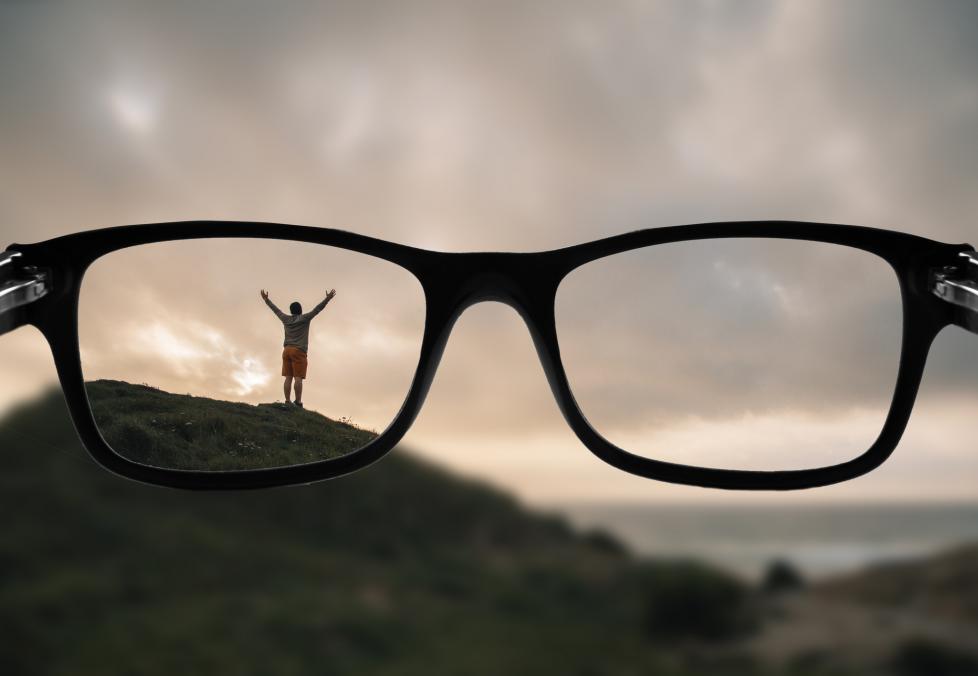
Two pairs and a free, quality eye exam for just $79.95
Everything you need to know to take care of your eyes — for life.
It’s not just your imagination — your eyes really are playing tricks on you. Here’s what might be up.

Street signs looking a little off? Wondering if you accidentally turned down the brightness in the bedroom?
There are lots of reasons your eyesight can suddenly seem different. One is obvious: You need new eyeglasses or contact lenses. But for many people, the culprit far less obvious.
“People often come in thinking they just need a pair of glasses,” says Jeff Foster, O.D., an optometrist at an America’s Best Contacts & Eyeglasses in San Antonio, Texas, “but it turns out to be something else.”
If you ever experience any abrupt vision changes, book an appointment for an eye exam right away. Meanwhile, protect your eyesight by watching out for some of these more common “sneaky” perpetrators.
Have questions about your eye health or vision? Your America’s Best optometrist is here to help. Click here to find an exam time that fits your schedule.
Millions of Americans experience dry eyes, partly due to hours spent staring at phone and computer screens. Mostly, dry eye is a nuisance, but it can affect vision as well.
“Seventy percent of all the clarity we see comes from tear film,” says Dr. Foster.
In fact, severe dry eye can lead to a condition known as superficial punctate keratitis, marked by decreased vision and sensitivity to light, he says.
“It’s almost like trying to see out of a dirty window,” Dr. Foster explains. “I had one patient, a younger girl, and we just weren’t getting a good reading of her eyeglass prescription. It was all over the place.” Sure enough, the girl had severely dry eyes.
In these cases, artificial tears and a prescription eye ointment or eye drops can help clear things up. After a round of steroid eye drops supplemented with artificial tears, Dr. Foster’s patient’s vision returned to her normal prescription.

Two pairs and a free, quality eye exam for just $79.95
A long list of medications can have side effects that impact your vision or the health of your eyes: birth control, arthritis and heart medicines, along with antidepressants, to name a few.
Even allergy medications can dry out the tear film that keeps eyes lubricated and healthy, leading to a blurred view.
John Perez, O.D., an optometrist who works at an America’s Best in Layton, Utah, recalls one 14-year-old patient who’d been taking high-dose antihistamine injections to treat allergies.
“She came in for a regular glasses exam, and her corneas were so dry and beat-up,” he says, adding that he saw signs of an ocular surface disruption known as punctate epithelial erosion, which is unusual for healthy adolescents. “It was because of the medication she was taking, and they had no idea.”
Notice blurred or distorted vision after starting a new medication? Talk to both your eye doctor and your family doctor, says Dr. Foster. Together they can find solutions—from switching doses to using an alternative medicine—that will keep you healthy and seeing well.
In the case of Dr. Perez’s young patient, she stopped the high-dose allergy meds and started treatment for her ocular surface disruption. Since then, he says, her vision and dry eye symptoms have shown “very good improvement.”
High blood pressure, diabetes, and other health conditions can damage blood vessels all over your body, including the small blood vessels inside the eye where focused images come together.
This can lead to retinopathy, when these blood vessels begin to bleed, distorting vision. (If untreated high blood pressure is to blame, you may be diagnosed with hypertensive retinopathy; uncontrolled high blood sugar can lead to a diabetic retinopathy diagnosis.) Patients may notice “floating” spots—kind of like a lava lamp, says ophthalmologist Rachel Bishop, M.D., a spokesperson for the National Eye Institute.
What’s more, high blood sugar can alter the shape and structure of the lens, necessitating a higher prescription for those with diabetes, adds Dr. Foster. Early-stage retinopathy may not have symptoms, but it will be spotted during a comprehensive eye exam.
Those with diabetes or high blood pressure also have a heightened risk of retinal vein occlusion, a blockage in blood flow that happens most often in older adults and almost always occurs in just one eye. As with retinopathy, early detection is always best.
Women may experience vision changes due to hormone fluctuations, such as during menopause or pregnancy.
That’s because estrogen levels affect the eye’s oil glands, leading to dryness as well as corneal stiffness, affecting how light enters the eye. The dryness and refractory changes can prompt blurry vision, according to the American Academy of Ophthalmology (AAO).
Men tend to be spared vision changes due to age-related hormone fluctuations, says Dr. Perez, but the AAO notes that surging hormones during puberty can lead to a fuzzy view. That’s why it’s a good idea to schedule regular eye exams for your tweens and teens.
Blurriness tends to resolve once hormones balance out, but see your eye doctor for any sudden vision changes to rule out other eye conditions.
Just as your skin can suffer acute sun damage, your eyes can, too. It’s called photokeratitis, a painful condition that causes redness and irritation on the cornea—like having sunburn in your eye. One symptom is blurry vision.
An extreme form is snow blindness, which can occur in skiers and climbers who are exposed to very high UV levels due to high altitude and the snow’s ultra-bright reflection.
Generally, the condition clears up on its own after a day or two. But you can prevent it from happening in the first place by wearing sunglasses that block 100% of UV rays.
Bonus: Wearing sunglasses also cuts your risk of developing cataracts later in life.
Eye diseases can be sneaky because they may not show any symptoms early on. Glaucoma, for example, often goes unnoticed until it’s quite advanced. At that point, people may notice blind spots in their peripheral vision.
Cataracts can lead to cloudy or blurred vision, and macular degeneration can cause straight lines to appear wavy, or a blurry or empty space in the center of your vision.
They’re even sneakier when they develop in just one eye, because the other eye may compensate for the weaker one, so you don’t notice anything is wrong. That’s why it’s a good idea to periodically close each eye to check your vision in the other.
If you do notice any vision changes, book an eye appointment right away. Even better, keep up on routine yearly exams so your eye doctor can look out for early signs.